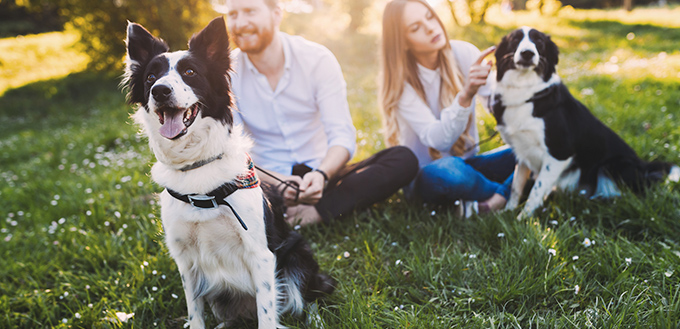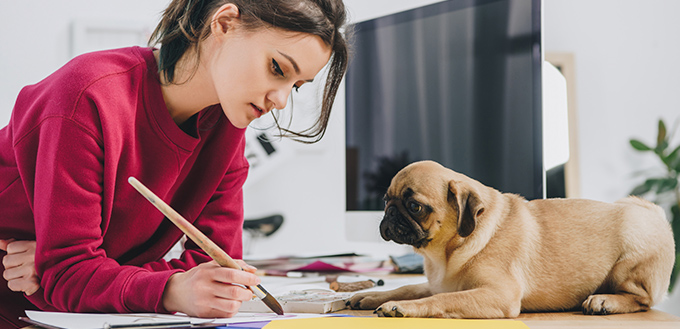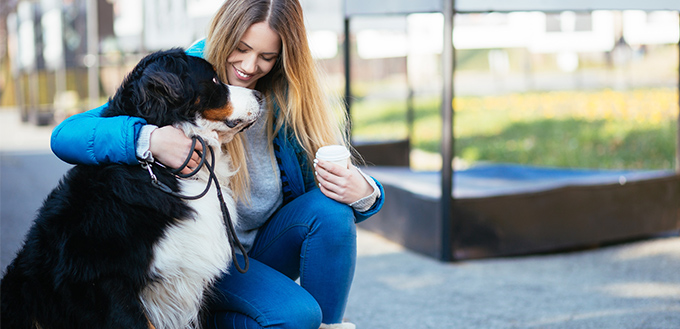As dog owners, one of the best things we can do is learn how our dogs read human body language and interpret it. It can help us cope and manage with their reactions which is particularly important if our pet canines seem to be exhibiting some unacceptable behavior, like barking when guests come into the house or even snarling when a human approaches them. Plus, by knowing how dogs read human body language, we can adjust our actions so that our dogs are happier and we can actually control their behavior in this way.
In this guide, we therefore look at ways that dogs may interpret our postures, mannerisms and actions. We then investigate why they react in the way they do to that very body language. It may really open your eyes to how your dog reads your body language very differently to how you are actually feeling.

1. Eye Contact
Eye contact is a much forgotten about part of our body language that is key to building a relationship with a dog, or at least ascertaining how they feel about being approached. In the main, it is good to realize and remember that dogs, in general, do not like having direct eye contact. They see it as a threat or a challenge which means that you could be starting off a relationship with a pooch on the wrong foot if you try to go up to a dog looking him or her directly in the eye.
Instead, what is best to do is try what is known by dog behaviorists as soft eye contact. Having some form of eye contact with dogs is necessary to build relationships so try a softly softly method when it comes to looking your dog or someone else’s pet in the eyes. All soft eye contact is, is looking at a dog briefly in the eyes and then looking away.
All that being said, it is good to teach a dog to cope with direct eye contact as it is such a common action by humans. In doing so, as owners, we are keeping our dogs safe by teaching them good behavior that is tolerated by humans. In fact, some dog behaviorists that work with rescue dogs often find that dogs who are able to look at humans in the eye for a short period of time is a reason to feel positive about that dog’s chances of being homed successfully. The reason being is that a dog will only have learned that from a human and through having formed a relationship with a person.
2. Our Hands
Knowing what to do with our hands when meeting a dog is key to ensuring that a dog responds positively to us. It can actually keep everyone safe, children in particular, if learned how to be done properly as it can make such a big difference as to a dog’s immediate reaction – especially if you are meeting a dog for the first time.
The immediate reaction for so many of us is to put our hands on a dog’s head and pat them or stroke them. However, this is read by dogs as a sign of dominance by you, the human. They simply do not like it if that is the first thing a human does to them the first time they meet them. Some dogs with behavioral issues won’t tolerate it like more placid, well-socialized canines may do. Unfortunately, this can therefore lead to instances where a dog growls, nips or bites at the person approaching them.
The best thing to do when approaching a dog for the first time, therefore, is actually just to hold your head out in front of their noses. This may sound counter-intuitive if you are worried they may bite you, but it is by far the safest way to bring a dog onside. The reason being is that they are able to smell you and it also is a far more passive and non aggressive way (in your dog’s eyes) of being approached. From there, it is possible to touch a dog for the first time by turning the palm up and going to scratch or pet them under their chin.
Greeting a dog in this way will mean you are far more likely to have a happier dog and better bond with them from the outset.

3. Where Our Body Is Positioned
Knowing where our bodies are positioned when meeting a new dog is fundamental to establishing a relationship on the best possible terms from the first instance. In short, when meeting a dog for the first time, it is good to remember that how we greet humans for the first time should be very different to how we greet dogs. While as humans we will tend to meet face to face, if we meet a dog square on while standing up, they will find this incredibly intimidating and domineering. In fact, they will find the whole situation threatening and all their subsequent reactions to you will be under duress due to the stress that the new human they are meeting is causing them.
Instead, try to look at it from a dog’s point of view – literally. Bend down and make yourself as small as possible so that you are at their level when you meet them. Plus, try to come up to them slowly while you do so and preferably not front onwards. Most dog behaviorists recommend meeting dogs, especially timid ones, from the side, which can really help when meeting a nervous rescue dog for the first time.
4. How Our Bodies Move
Second to how our bodies are positioned when we first meet a dog, is how our bodies move when meeting them too. In the main, even placid, relaxed dogs do not like sudden movements that are unexpected when meeting anyone, especially when meeting tall humans for the first time. As a result, try to remember to keep your movements slow and steady, with no quick flinches or jerks. Much like meeting a dog face, they will find these movements intimidating and threatening and from that point onwards will be wary of you until they deem that threat to have been removed. You can stop this from happening and start your relationship off as strongly as possible with a new dog, but taking things slowly and calmly with them.
If you have children who love dogs, this can be a key point to try to instill in them given that children are not known for moving slowly or staying still.

5. Our Stature And Demeanor
Not all dog behaviorists agree on this one, but some more sensitive dogs most probably do pick up on our demeanor. Unfortunately, this can be one of the most difficult parts of our body language to adjust to ensure that when we meet a dog for the first time – be they a potential pet or simply a friend’s dog – that the meeting starts off well, thus establishing a good relationship from the outset.
Essentially, however, if you are nervous around a dog there is a high chance that they will pick up on those nerves and think something is off. This can mean they may exhibit protective behavior towards any other family members nearby or simply protective behavior with regards to looking after themselves. If you are relaxed and at ease, this will far more likely not be the case. The dog will know instinctively that you have no other intentions, especially if you have approached him or her taking into account all the above tips.
How Dogs Read Human Body Language – The Bottom Line
Taking all these tips on board may sound overwhelming at first, but it can be key to a dog’s happiness and their ability to interact with humans. It’s also key to keeping yourself and others safe, as if you approach a dog in a way that they are most likely to interpret as being a threat, you are far more likely to have a nasty altercation with them. Knowing how a dog reads a human’s body language should also go hand in hand with a human knowing how to read a dog’s body language. Whenever they have their tail between their legs, their hackles up or the ears back – we should be aware that this is a sign of stress and that approaching a dog in such a state, especially in a way that they find intimidating, is a big no no.







